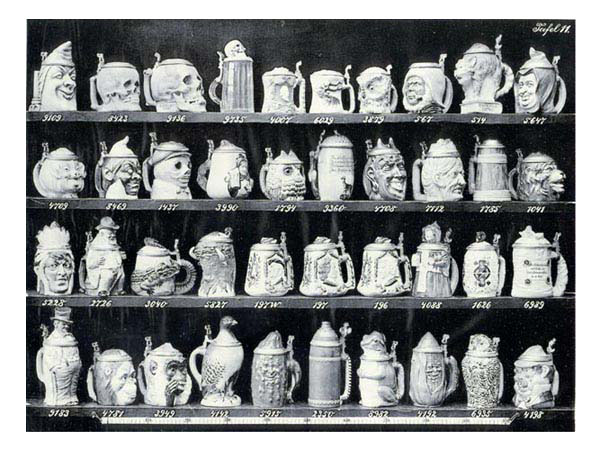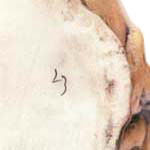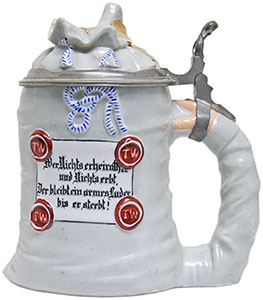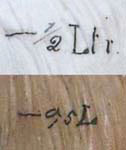
by Frank Loevi
This article is intended as an adjunct to the on-line Ernst Bohne Söhne Stein Catalog in the Beer Stein Library. Various links provided herein will take the reader directly to examples provided in the catalog. After viewing a catalog example, use the “Back” button on your Internet browser to return to the article.
When it comes to manufacturers of porcelain character steins, few would argue with the proposition that the Rudolstadt firm of Ernst Bohne Söhne, which operated during the late 19th and early 20th centuries, produced of some of the finest examples of its era. Today, Bohne steins are highly valued by collectors, often commanding prices of several thousand dollars or more. In this article, we’ll briefly explore the history of the company and then look at some of the unique characteristics of Bohne steins that can be used as an aid to identification.
A Brief History
The company was founded in 1848 by Ernst Bohne, a German porcelain painter. By 1850 Bohne had purchased his first kiln and had begun producing his own wares, although it is doubtful that any beer steins were produced until well after the company was taken over by Bohne’s three sons following his death in 1856, at which time it was renamed Ernst Bohne Söhne (Ernst Bohne Sons).
Beer stein collectors unfamiliar with the company often assume that its production efforts were concentrated on beer steins. In fact, nothing could be further from the truth. In the earliest known catalog of Bohne wares (circa 1900), some 716 items are pictured, only 40 of which are steins. The remainder of the catalog contains a wide variety of wares, dominated by porcelain figurines.
Taking a look at the single page in that early catalog (out of a total 24) that contained beer steins (Fig. 1), it is also interesting to note that not all of them are figural (character) steins. Assuming that mold numbers were issued sequentially, it would appear that the first three Bohne steins were of the non-figural variety, produced to honor three major German composers — (Mozart, No. 196), (Beethoven, No. 197), and (Wagner, No. 197W). Again relying on mold numbers for guidance, it is also reasonable to conclude that the first figural stein (Tomcat, No. 514) was not produced until some time thereafter, probably not until near the end of the 19th century.
 |
During the late 19th and early 20th centuries, the firm of Ernst Bohne Söhne flourished, winning several national and international awards for its work, culminating in 1915 with a gold medal at the Panama-Pacific International Exposition celebrating the opening of the Panama Canal. Unfortunately, that was to be the last award won by the company. With the onset of World War I in 1914, the handwriting was already on the wall. By 1919, production had virtually ceased and the heirs of Ernst Bohne were forced to sell the company to Gebr. Heubach (Heubach Brothers), a porcelain manufacturer from the town of Lichte, perhaps best known today for its high-quality porcelain dolls.
Heubach continued to operate the Rudolstadt factory using the Bohne name until 1930, when degenerating economic conditions in Germany finally led to the firm’s bankruptcy. Surviving records appear to indicate that during the period from 1919 to 1930 few beer steins were produced, with the exception of figural skull (“totenkopf”) steins, part of an extensive group of skull-based items ranging from toothpick holders to tobacco jars and from shot glasses to chalices. Even today, Bohne skull steins are the company’s most recognizable icons, perhaps best exemplified by the (Skull on Book) stein, which was particularly popular in its day among German student societies.
Following the Heubach bankruptcy, the factory remained closed until 1937, when it was purchased by a small group of investors headed by Albert Stahl, an accountant who had worked for Heubach at the Rudolstadt facility. Although Stahl continued to operate as Ernst Bohne Söhne immediately following the purchase, available evidence seems to indicate that beer steins were not among the items being produced, having been displaced by a more marketable line of dinnerware.
Today, the original 19th century Bohne facility is operated under the Stahl name by the heirs of Albert Stahl. Within its current product line are both reproductions of some of the early Bohne character steins and a number of new character steins designed to appeal primarily to American audiences. However, the fact is that one of the most well-known porcelain character stein factories in the world did not produce a single stein between 1930 and 1985 — a period of 55 years!
Bohne Stein Characteristics
Base Marks — Over the years, the Bohne factory used several different marks to identify its products. However, it should be noted that the majority of Bohne steins carry no mark at all.
The most often seen base mark is an anchor, with an “E” on the left side of its shank and a “B” on the right (Fig. 2). From about 1885 through 1919 the mark varied somewhat in both the shape of the anchor and the placement of the “E” and “B”, but was generally configured as depicted in the example. The anchor mark was applied both in an impressed form and as a stamp using blue ink. When it is impressed, it is normally found near the handle attachment point, and is often seen in conjunction with an impressed mold number (Fig. 3). The blue ink version of the Bohne anchor (Fig. 4) was probably not used until the beginning of the 20th century. It can be found in varying sizes and is sometimes seen in conjunction with an impressed “E.B.S.” written in fairly large block letters.
|
|
|
|
Sometime toward the end of World War I, and possibly not until the factory was taken over by Heubach, the anchor mark was replaced by a mark depicting a crown over an “N” (Fig. 5). Like the anchor mark, the crown-over-N mark can be seen in a variety of different configurations. Figure 5 is an attempt to display a range, rather than just two specific examples. The crown-over-N mark is always found in blue ink and is a representation of the old “Capo-di-Monte” mark used on some Italian soft porcelain figurines and other porcelain products (the “N” stands for Naples). The crown-over-N mark had been applied by the Bohne factory as early as the late 19th century on Capo-di-Monte imitations, and was clearly not initially intended to become the de facto Bohne mark. However, for reasons that may never be known, many later Bohne beer steins now carry that mark.
It is important to note that marks similar to the Bohne crown-over-N were used by a number of German porcelain manufacturers on their own wares. Moreover, Capo-di-Monte is known to have manufactured beer steins that bear the mark in its original form. Consequently, not every beer stein with a crown-over-N mark can be attributed to the Bohne factory.
 |
Thumblifts — The Bohne factory used a wide variety of thumblifts on its steins over the years, ranging from fairly ornate to very plain. By far the most common thumblift on Bohne steins, appearing on perhaps as many as 25-30% of known examples has an entwined flower design (Fig. 7). Making this thumblift quite useful as a Bohne identifier is the fact that it is only rarely seen on steins from other manufacturers. Somewhat less unique, but still providing some help in identifying a Bohne stein is a blank shield or crest thumblift (Fig. 8), seen on about 10% of known examples.
|
|
|
|
|
Bohne also used several different figural thumblifts, matching the subject-matter of the thumblifts to that of specific steins. For instance, the Artillery Shell stein is generally found with a thumblift consisting of a helmet over a pair of crossed hand-grenades (Figure 9). Similarly, the Munich Child in Barrel stein is almost always graced with a thumblift depicting the twin towers of Munich's Frauenkirche (Fig. 10). Unfortunately, although these two thumblifts may be particularly appropriate for the steins in question, they were not unique to Bohne and provide little aid in identification. On the other hand, the Snufftaker, Tomcat and Munich Child steins are often found with an unusual thumblift depicting a sausage and a radish (Figure 11), which is seen almost exclusively on Bohne figurals.
 |
 |
Also characteristic of Bohne steins is the fact that they all have external, hand-painted capacity marks. Unfortunately, there doesn’t seem to be any consistency in the nature of the capacity marks that would provide additional help in identification. Figure 13 shows the capacity marks from two half-liter Monkey steins that are identical except for coloring. Note that one is stated as a fraction and the other as a decimal number. Even the abbreviation for liter is different on the two steins. Consequently, the only real clues provided by the capacity marks are the facts that they are hand-painted and on the exterior of the steins. While that doesn't help a great deal in determining that a particular stein was produced by Bohne, the absence of such markings almost certainly indicates that it wasn't.
The Known and the Unknown
Although collectors in the U.S. have been aware of Bohne steins for many years, because the factory was located in the former East Germany, the first solid documentary evidence about the company and its products did not begin to emerge until the fall of the DDR in 1990. Much has been learned since that time, but there are still many gaps that need to be filled in. Catalogs and other documents discovered recently at the factory have helped immeasurably in confirming what could only be guessed at in the past. In some cases, old catalogs have even provided information about steins that have not yet been seen by collectors (for instance, the 0.3-liter version of one of the Bohne Owl steins).
Based on the information that we now have, it is also clear that substantial gaps exist in the documentary evidence that has survived. This is periodically confirmed by the discovery of Bohne steins that are not listed in currently available catalogs (see, for instance, the Moritz stein).
The Ernst Bohne Söhne Stein Catalog in the Beer Stein Library is an attempt to build a complete compilation of all the beer steins known to have been produced in the Rudolstadt factory from its founding through the 1930 bankruptcy and closure. To the extent that users of the catalog can add to that effort with new discoveries, your contributions are strongly encouraged and will be much appreciated.
__________
© 2000-2025 Beer Stein Library — All rights reserved.